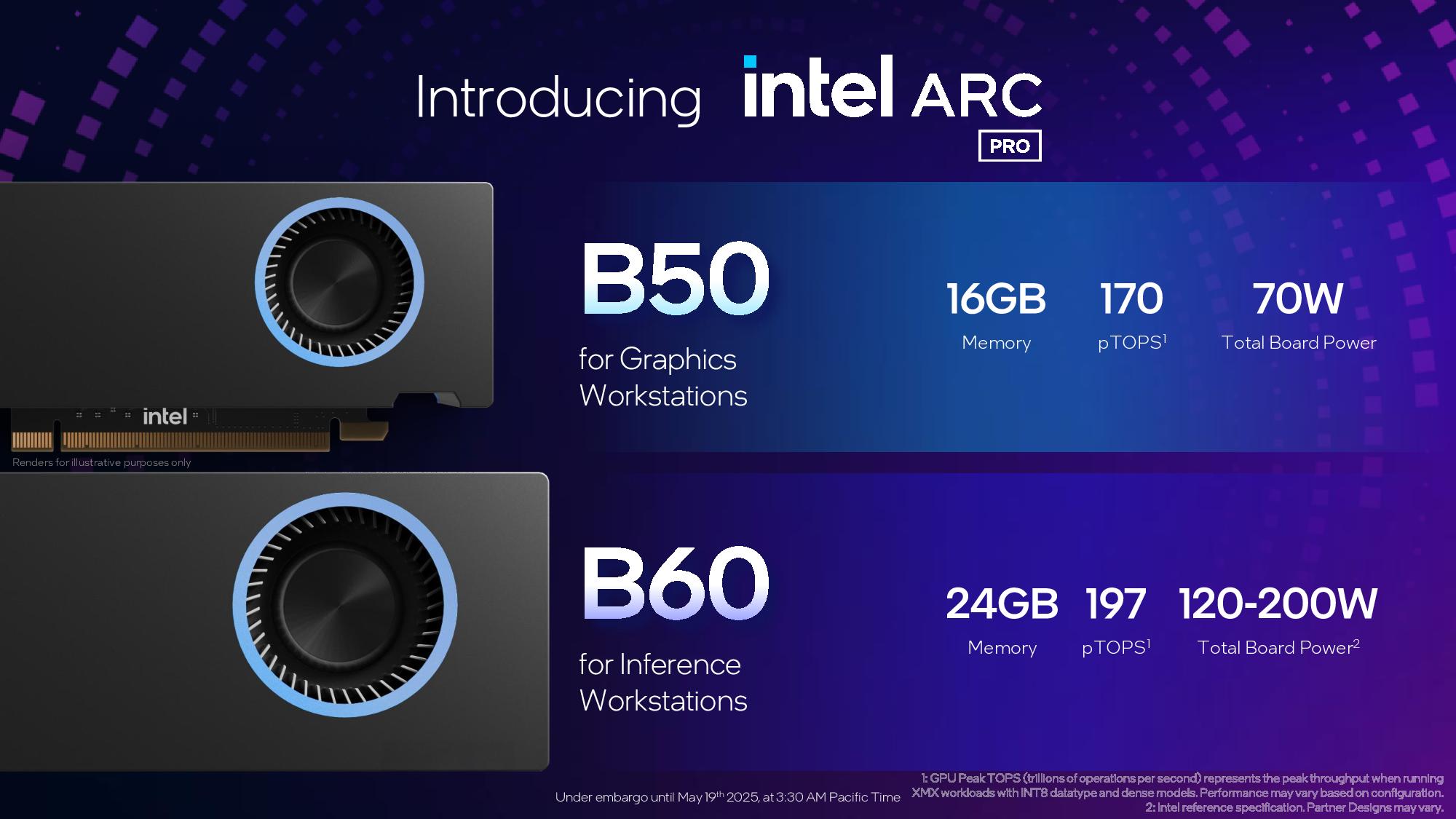Powerful AI Workstation GPUs for the USA
The Intel Arc Pro B50 is making waves in the professional GPU market, offering a powerful blend of performance, efficiency, and affordability. Designed for engineers, creators, and AI developers, this 16 GB VRAM graphics card delivers the horsepower needed for today’s demanding workloads.
What sets it apart is its compact dual-slot design for slim workstations, making it ideal for smaller rigs without compromising power. With 16 Xe cores and 128 XMX engines, it’s engineered to handle AI inference workstation GPUs and complex rendering tasks with ease. The PCIe 5.0 interface ensures fast data transfer, boosting overall productivity. Intel’s latest release is a bold step forward in workstation graphics cards.
(Image credit: Tom’s Hardware)Detailed Overview of Intel Arc Pro B50 and B60 GPUs
The Intel Arc Pro B50 is a $299 Arc Pro B50 with 16 GB memory graphics card. It uses a compact dual-slot design for slim workstations and operates within a 70W total board power rating. This makes it energy-efficient while still offering solid performance. It packs 16 Xe cores and 128 XMX engines that help accelerate AI tasks and professional workloads. The B50 suits users who need balance between power and efficiency, especially in smaller workstation setups.
On the other hand, the 24 GB Arc Pro B60 GPUs step up with 20 Xe cores and 160 XMX engines, reaching 197 peak TOPS with 20 Xe cores and 160 XMX engines for demanding AI inference tasks. This card supports heavier workloads with a larger GPU memory capacity and faster speeds. It is also used in specialized configurations like the Maxsun dual-GPU card based on B60 GPU, which can power intense multi-GPU setups. Together, the B50 and B60 give users options from budget-friendly to high-end performance.
Project Battlematrix: Intel’s Approach to AI Inference and Workstations
Project Battlematrix is Intel’s ambitious plan to combine hardware and software into a powerful platform for AI and workstation users. It leverages Xeon processors alongside Arc Pro GPUs to create pre-built inference workstations costing $5,000 to $10,000. These setups are designed for AI researchers and developers who need reliable, scalable performance. Intel’s goal is to improve AI model throughput using GPU concurrency scaling for AI models, allowing better efficiency with multiple GPUs.
These workstations support dual-GPU configuration and even larger setups with eight GPUs with 192 GB total VRAM support. Intel also promotes an open enterprise platform for building RAGs (retrieval-augmented generation models). The combination of GPUs, CPUs, and full software stack helps businesses deploy AI workloads faster and more cost-effectively. The platform supports containerized AI development and large model training with ease.
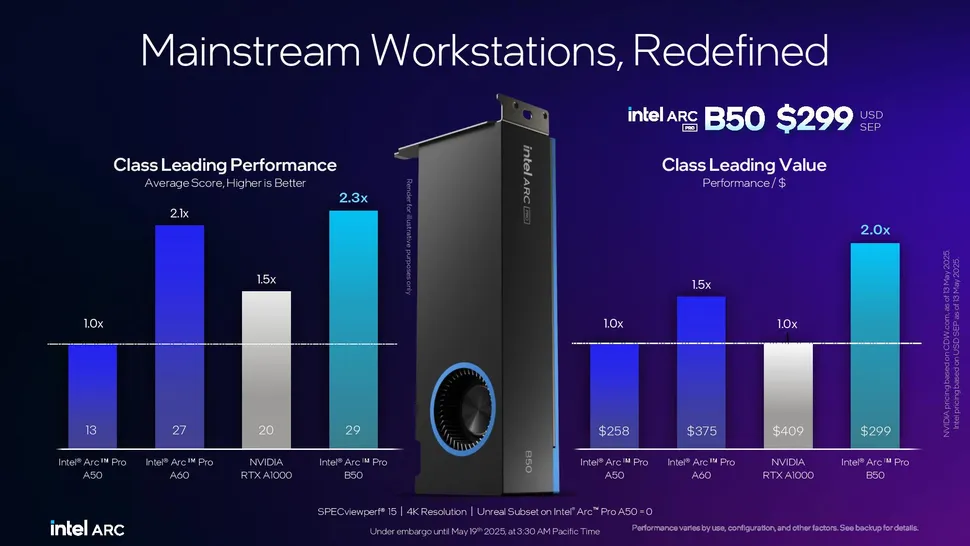
Technical Specifications and GPU Architecture
The architecture of the Intel Arc Pro B-Series is built around Xe cores and XMX engines, which are custom AI accelerators. For example, the Intel Arc Pro B50 has 16 Xe cores and 128 XMX engines, while the B60 offers 20 Xe cores and 160 XMX engines. These cores provide both graphical rendering and AI computation in one package. The cards use a PCIe 5.0 x8 interface speeds transfers, doubling the data transfer rates compared to PCIe 4.0. This ensures fast communication between GPU and CPU.
Memory bandwidth is also crucial. The VRAM memory bandwidth in these GPUs supports high throughput, essential for large AI models and complex graphics tasks. Power ratings stay relatively low, with the B50 operating at about 70 watts. This efficient architecture lets workstations stay cool and quiet, even under heavy workloads. Intel has worked to balance speed, power consumption, and compatibility for professional environments.
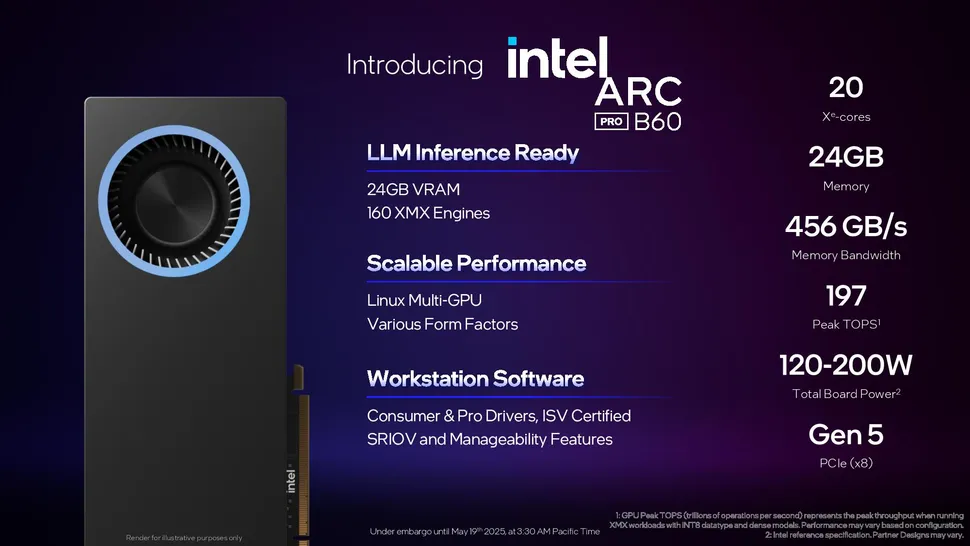
Performance Benchmarks and Real-World Use Cases
Intel claims that the Intel Arc Pro B-Series delivers up to 2.6X more performance with certified drivers compared to previous Arc GPUs. In benchmarks, these cards hold their own against competitors like the Nvidia RTX A1000 competitor and even the RTX A50 6 GB in some AI tasks. For example, tests using AI workloads and graphics rendering show solid gains in speed and efficiency. These results are impressive for professionals who demand reliability.
In real-world use, the GPUs handle AI model training, video editing, and 3D design smoothly. Intel’s benchmarks vs Nvidia RTX A1000 8 GB and A50 6 GB demonstrate the GPUs’ strength in accelerating AI inference workloads. For instance, the running 675B parameter DeepSeek model on an eight-GPU system shows how well the hardware scales in large AI environments. These capabilities make the Arc Pro B-Series a serious choice for AI and content creation.
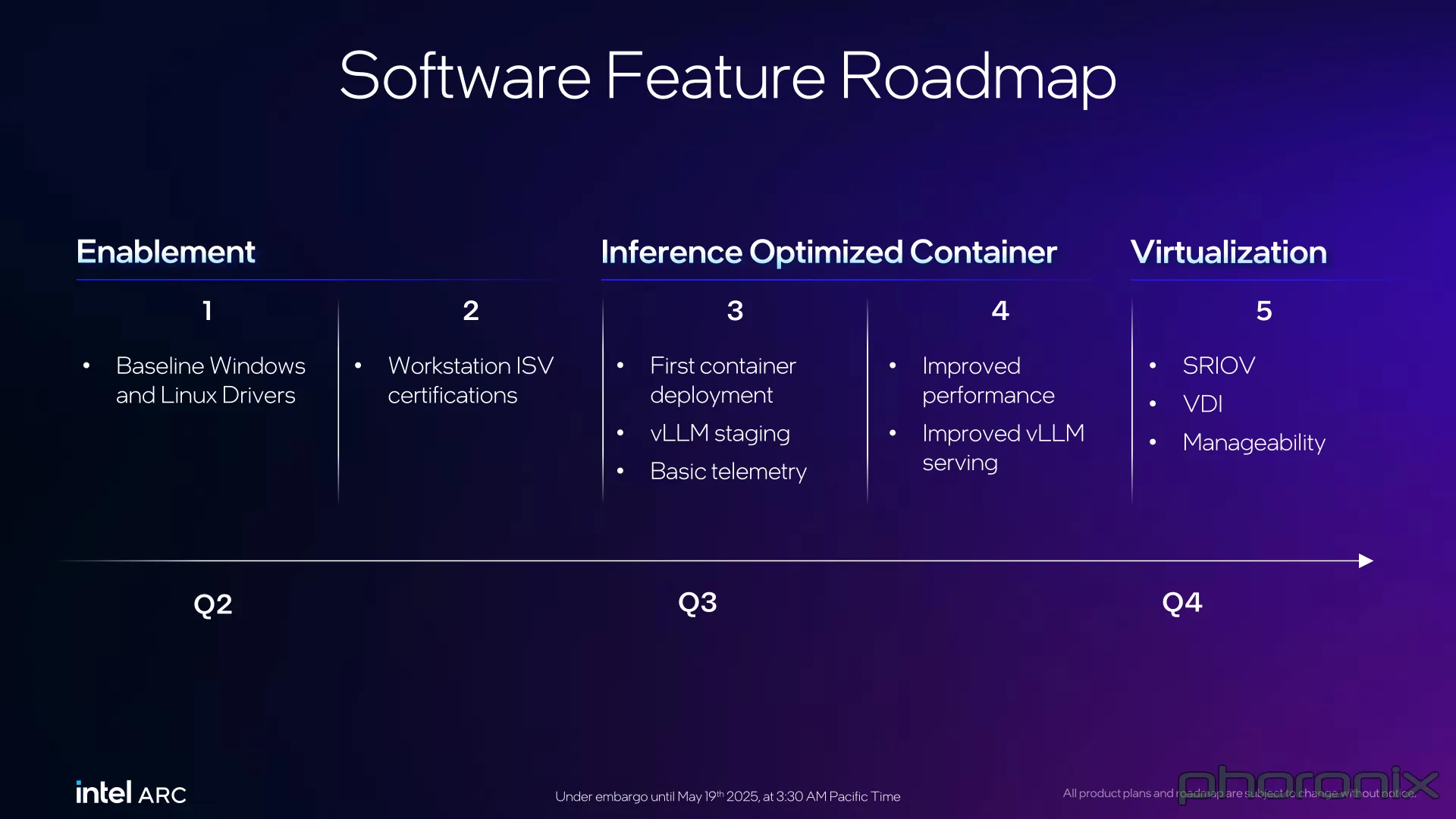
Software Ecosystem: Linux Improvements and Driver Support
Intel’s commitment extends beyond hardware to software. Their Linux software improvements include a full-stack containerized Linux solution that simplifies deploying AI workloads in professional environments. This solution integrates deployment of SRIOV, VDI, and manageability software, making the GPUs compatible with virtual desktop infrastructures and containerized workflows.
Another critical factor is ISV certification, ensuring compatibility with leading software used by professionals. The improved driver support means better stability and higher performance in real applications. These software enhancements help workstations get the most out of the Intel Arc Pro B-Series GPUs while maintaining smooth operation on Linux and other platforms.
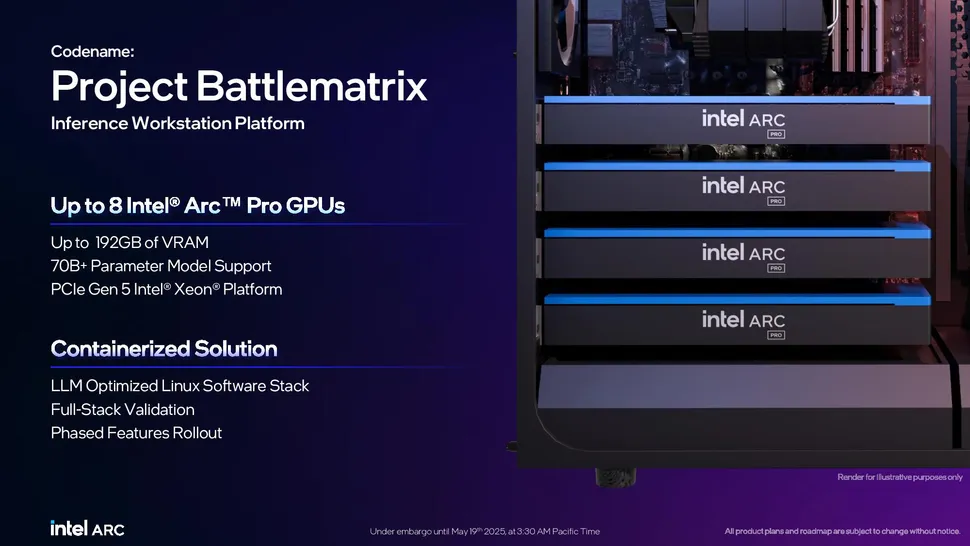
Market Positioning and Competitor Comparison
Intel is positioning the Arc Pro B-Series as a competitive alternative in the workstation market. Against giants like NVIDIA and AMD, Intel offers strong VRAM options, such as the 16 GB VRAM graphics card in the B50 and the 24 GB VRAM GPU in the B60. The compact dual-slot design for slim workstations and energy efficiency give Intel an edge for space- and power-conscious users.
Price-wise, Intel aims to attract cost-sensitive buyers who want good AI inference performance without breaking the bank. The market positioning targets users needing solid AI acceleration and workstation graphics. While NVIDIA dominates with the RTX series, Intel’s growing GPU benchmarks and feature set create a promising challenge in professional environments.
Use Cases: Workstations, Content Creation, and AI Applications
The Intel Arc Pro B-Series excels in several professional scenarios. For AI researchers, these GPUs offer AI workload acceleration to speed up training and inference. Content creators benefit from high-quality graphics and smooth video rendering thanks to powerful GPU cores and large VRAM sizes.
Workstation users find value in the Project Battlematrix AI workstations because they combine GPUs with Xeon CPUs and software that support demanding tasks like 3D modeling, video editing, and scientific computation. This versatility makes Intel’s solution ideal for creative professionals, engineers, and AI developers alike.
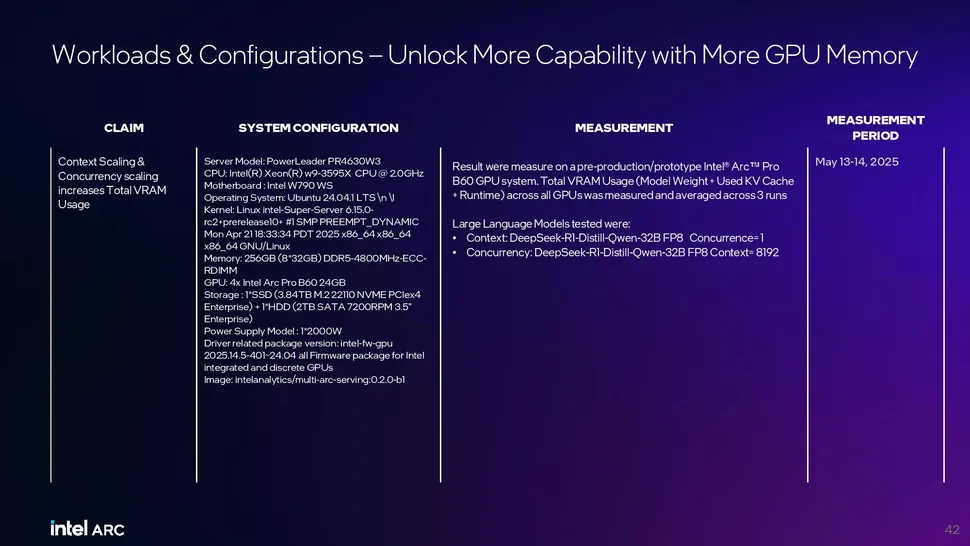
Pricing, Availability, and Future Roadmap
Intel has priced the Arc Pro B50 competitively at around $299. The 24 GB Arc Pro B60 GPUs come at a higher cost, reflecting their superior capabilities. These GPUs will be available in the USA soon, with Project Battlematrix workstations expected to hit the market between $5,000 and $10,000. This range targets professional buyers who need ready-to-use AI and workstation solutions.
Looking ahead, Intel plans continued software updates to improve performance. They aim to expand Linux software improvements and increase compatibility through further ISV certification. The future roadmap also includes support for larger GPU clusters and enhanced AI model concurrency, promising even faster AI inference and better workstation experiences.
Conclusion: What Intel Arc Pro B-Series Means for Professionals
The Intel Arc Pro B-Series and Project Battlematrix represent a significant advance for professionals in the USA. These GPUs combine efficient hardware with software designed for demanding AI and workstation needs. From the affordable Intel Arc Pro B50 to the powerful 24 GB Arc Pro B60 GPUs, Intel is offering versatile tools that rival established competitors.
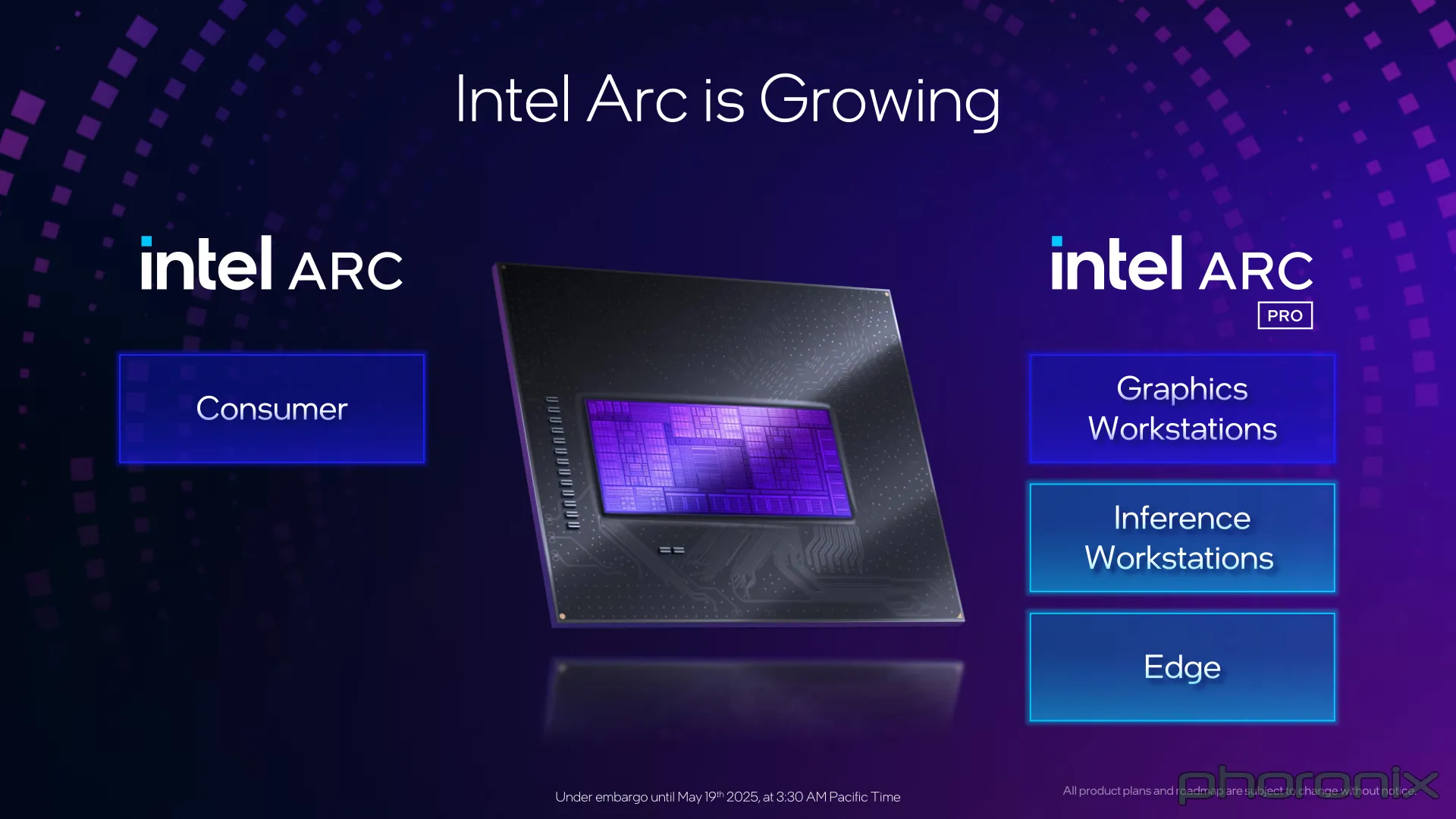
For AI researchers, content creators, and workstation users, this means more options to build powerful setups that handle large models and complex graphics smoothly. Intel’s ecosystem, including containerized Linux solutions and multi-GPU scalability, ensures professionals stay productive and future-proof. The Arc Pro B-Series is a solid contender to watch in the evolving world of AI and professional graphics.
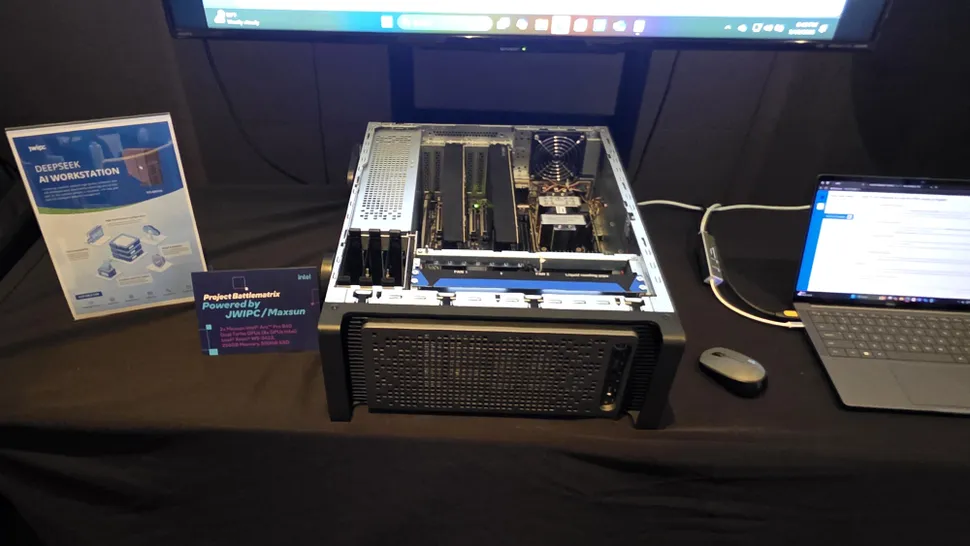
Table: Quick Comparison of Intel Arc Pro B-Series GPUs
| Feature | Arc Pro B50 | Arc Pro B60 |
|---|---|---|
| VRAM | 16 GB VRAM graphics card | 24 GB VRAM GPU |
| Xe cores | 16 Xe cores | 20 Xe cores |
| XMX engines | 128 XMX engines | 160 XMX engines |
| Power consumption | 70W total board power | Higher, suitable for heavy AI |
| PCIe Interface | PCIe 5.0 x8 interface | PCIe 5.0 x8 interface |
| Target users | Slim workstations | High-end AI workstations |
| Approximate price (USD) | $299 | Higher, enterprise pricing |
This article has given you a clear view of Intel’s new GPUs and their potential. If you’re aiming to upgrade your AI workstation or content creation setup, keep the Intel Arc Pro B-Series and Project Battlematrix on your radar.
Read our previous article: Most Reliable Years for a Used Toyota GR86 (USA Guide)
